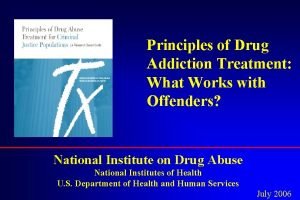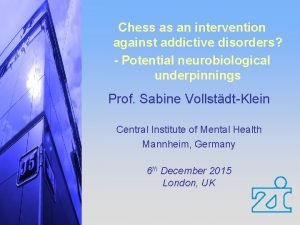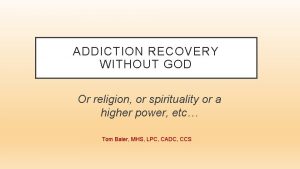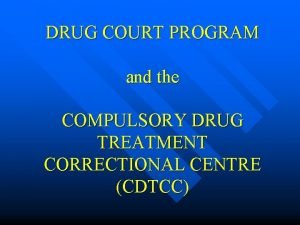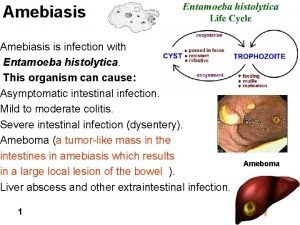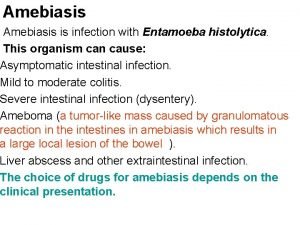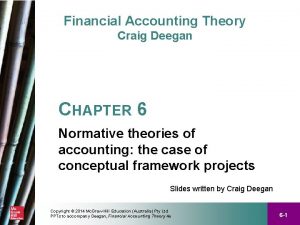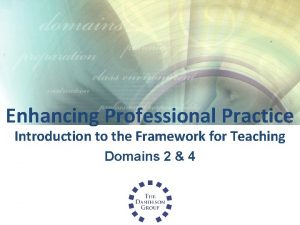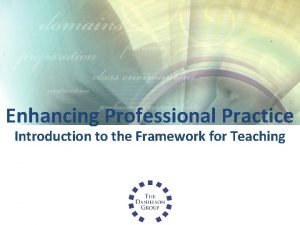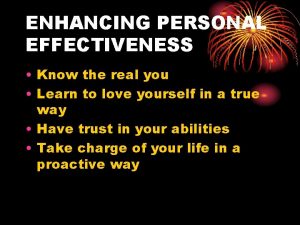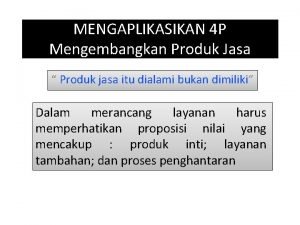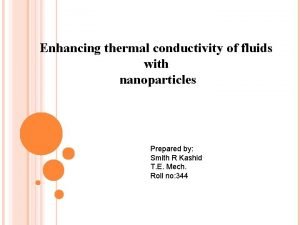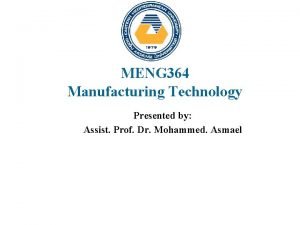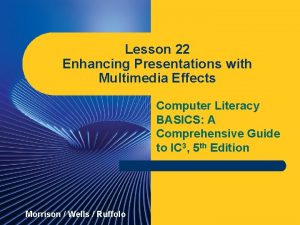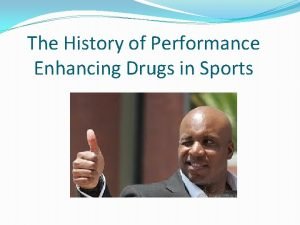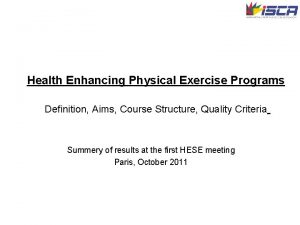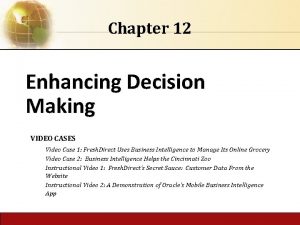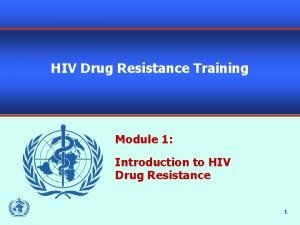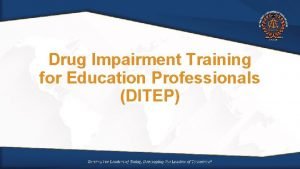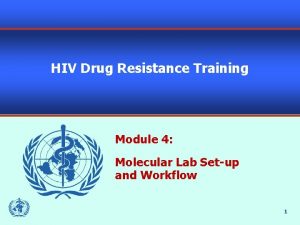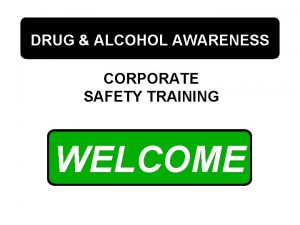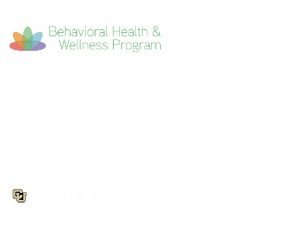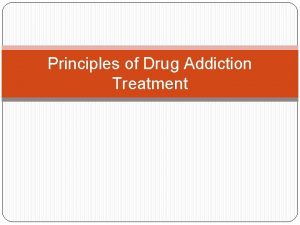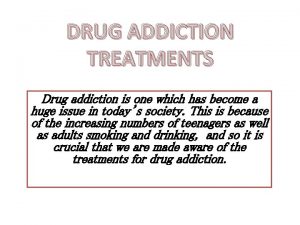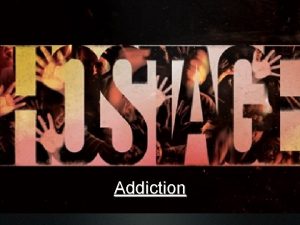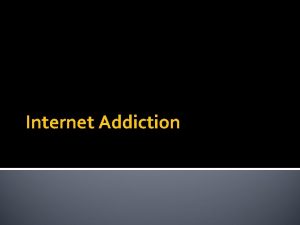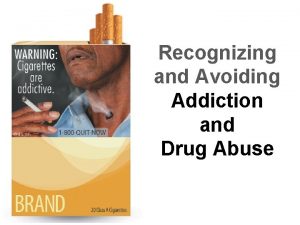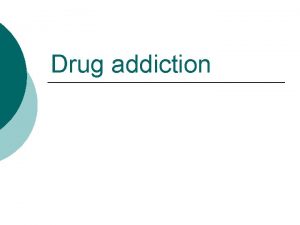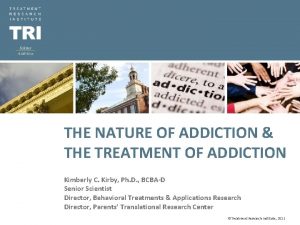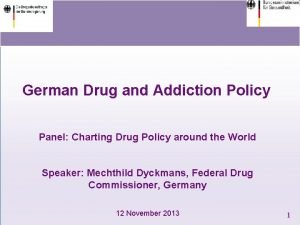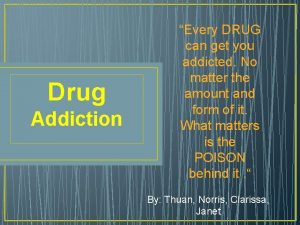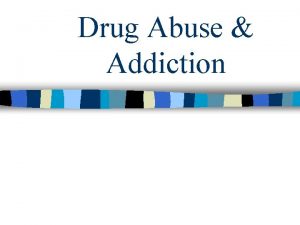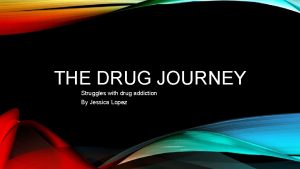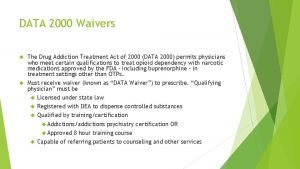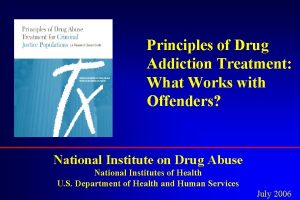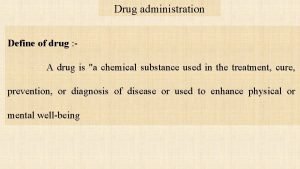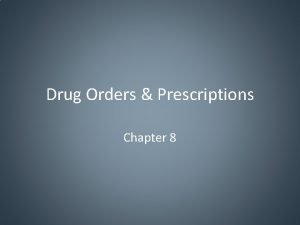Training for Enhancing Drug Addiction Treatment in China























































































- Slides: 87

Training for Enhancing Drug Addiction Treatment in China Dr. Mark E. Barrett, Consultant UNODC Ms. Karen May Yien Ling, Trainer UNODC July 2004

Introduction n Part One (day one) will introduce and summarize “Best Practices for Drug Addiction Treatment. ” n Part Two (day two) will introduce a “Recovery Training Program” for Compulsory Drug Treatment Centers in China.

Part one, day one n The first part will summarize and provide an overview of contemporary treatment approaches and best practices. n The purpose of this is to share with DRCs knowledge derived from several decades of research and program development about drug treatment. n Some approaches that are used elsewhere may not be suitable for China, and so the focus will be on what is practical and feasible for use.

Part two, day two n Part two, day two will present a basic 10 - module recovery training program that can be used within the Centers to provide addicts with knowledge and skills to aid in their recovery from drug addiction. n This recovery program is just a beginning and if interest develops it could be expanded. n The sessions will be simple and easy to use by DRC staff, requiring a minimum of preparation.

Presentation: Part One n Today’s summary (Part one, day one) comes from recent reviews by the US National Institute on Drug Abuse (NIDA), UNODC, and the Institute of Behavioral Research at Texas Christian University in the USA (www. ibr. tcu. edu). n The focus will be on more general findings that may be relevant for adoption in China; the reader is referred to these reviews for more detailed descriptions and references (see citations in introduction).

Reasons for using drugs n There are social, cultural and psychological reasons for using drugs. n Social and cultural variables include family, friends, customs (drinking at weddings) media (television, billboards) n In most cases peers play an important role in introducing drug use, providing drugs and encouraging the user to continue. n Strong ties to conventional institutions (family, school, religion), beliefs, values, activities and institutions can protect persons from becoming involved with drugs (Recovery involves strengthening those ties).

Psychological Causes Psychological reasons that persons use drugs are many: n n n Mood alteration (enhance positive, reduce negative moods) Beliefs about drugs (e. g. , harmful actions of drugs) Personality variables include n High levels of negative emotions (low self esteem, anxiety, depressed) n n Enduring desire for arousal, increased positive affect (sensation seeking, thrill seeking) Antisocial personality

Drug Misuse and Drug Addiction n Drug misuse is the inappropriate, unsafe or illegal use of drugs by choice, versus drug dependence, in which the addict has lost most power of choice. n Drug misuse is a behavioral problem that responds to coercion, education, and decreased availability, whereas drug addictions usually require intensive multidimensional therapy.

About Addiction n Research has shown that in addition to behavioral, social and psychological aspects, addiction is an illness that involves physical alterations to nerve cells in the brain as a result of repeated exposure to the drug. n This has important implications for treatment and rehabilitation.

Policies and Programs n The way addiction is viewed will strongly influence the type of policies and programs that governments will adopt to address the use of addictive drugs. n If it is viewed as primarily a moral or criminal matter, then the focus will be on punishment to deter use.

Policies and programs n On the other hand, if addiction is viewed as primarily a health issue (such as heart disease and diabetes), then policies will favor providing health care, including: n the most effective drug treatment and rehabilitation approaches, and, most importantly, n Measures to reduce health and other problems associated with drug use (such as spread of HIV and other illnesses, crime, disruption of families and communities).

APA Definition of Addiction The American Psychiatric Association's diagnostic manual defines addiction as follows: "The symptoms include tolerance (a need to increase the dose to achieve the desired effect), using the drug to relieve withdrawal symptoms, unsuccessful efforts or a persistent unfulfilled desire to cut down on the drug or stop using it, and continued use of the drug despite knowing of its harm to yourself or others. "

Physiological Basis of Addiction n Neurological studies have identified a common basis in the brain for all drugs that cause addiction (e. g. , nicotine, heroin, cocaine, alcohol, etc. ). n This site of action in the brain is the mesolimbic dopamine system, also referred to as the Brain Reward System. .

Brain Reward System

Brain Reward System n The Brain Reward System reinforces behaviors that generally are good for survival —e. g. , eating of sweet, pleasant tasting foods provides nutrition, drinking water, sexual activity leads to procreation, exercise improves one’s fitness, and so on. n The brain reinforces these behaviors to ensure that we continue to do them.

Addictive Drugs “Fool the Brain” n Addictive drugs such as heroin fool the brain by artificially creating pleasurable feelings (euphoria) and reinforcement (reward) for drug taking behavior. n In effect, drugs tell the brain to “take more drugs!”

Brain Reward System n Addictive drugs, like heroin, cause long lasting, possibly permanent, changes to the nerves in the area of the Brain Reward System. n This is why addiction is difficult to overcome and, why relapse occurs so often, and why it sometimes takes many years before addicts are successful in permanently stopping drug use.

Phenomenon of “Drug Craving” § Craving is an impulsion to reinstate drugtaking during abstinence and is associated with an activation of the Brain Reward System. Craving can be triggered by drug cues (needles, mirrors, pipes, etc) § § Unpleasant feelings of abstinence Pleasant recall of positive drug state

What are the implications of this view of addiction? • The fact that there are several addictive drugs that act at this site in the brain (Brain Reward System) also means that addicts may substitute one drug for another. • One example is to switch from heroin to amphetamine type substances or alcohol in order to reduce craving and withdrawal symptoms.

Bio-psycho-social Model Drug addiction has many aspects. n Biological (brain reward system) n Psychological (drugs may meet certain needs for the addict, such as relief of anxiety or depression). Learning is important in the addiction process. n Social (drug use almost always occurs as a social behavior, with drug using peers, and in a social environment).

Questions and Discussion about Physiological Basis of Addiction n What are the current views in China about addiction and its causes? n In what ways is the drug rehabilitation system in China consistent with the bio-psychosocial model of addiction? n In what ways does it differ?

15 Minute Break

Question (after break) Considering what we know about addiction, what would be the best way to help the drug addict to overcome addiction, and more immediately to prevent the spread of HIV and other risks to society that result from illicit drug use?

Answer The Health Oriented Approach to Harm Reduction would be the first step to achieve both of these goals.

Health Oriented Approach n The health oriented approach to harm reduction can be viewed as the prevention of adverse consequences of illicit drug use without necessarily reducing their consumption. n A good example is the compulsory wearing of seatbelts—it reduces harm, including death, which are associated with traffic accidents, but does not reduce the number of traffic accidents.

Health Oriented Approach n Harm reduction approach is also consistent with supply and demand reduction approaches. n The harm reduction approach identifies both short-term and long-term goals. Short-term: stop threat to public safety (spread of HIV Infection, crime) n Long-term: prevention and treatment and rehabilitation of drug addicts. n

Key Elements of Harm Reduction Approach n Drug treatment and drug substitution programs (e. g. Methadone) n Needle/syringe exchange programs n Primary Health Care n Counseling and Testing for HIV n Removing barriers to safer injecting n Peer Education Programs (such as using Indigenous Outreach Workers)

Outreach n Indigenous outreach workers (recovering drug addicts coming from the same backgrounds) can effectively reach out to drug addicts in the community n Outreach workers can reach drug addicts and teach them to prevent HIV infection. n Also, drug addicts can be encouraged to seek treatment (long-term goal).

CONTEMPORARY APPROACHES TO DRUG TREATMENT n We begin now our summary and review of evidence-based Best Practices in Drug Addiction Treatment and Rehabilitation. n The treatment process begins with Intake (or Induction into program) n Intake includes data collection, an assessment of the addicts background, drug use history, physical, psychological and social functioning, and problem areas.

Intake n There have been special data collection systems developed, such as those developed at the IBR at Texas Christian University (Dr. Dwayne Simpson, Director). (Please see www. ibr. tcu. edu) n These allow the counselor to see the addict’s problem profile (see next slide)

TCU BRIEF INTAKE 41 AGE GENDER EDUCATION SITE: CLIENT ID: DATE: 1 0999 5/6/99 09 LEGAL STATUS Yes LEGALLY MANDATED No HI NEED FOR TREATMENT Yes HI PRESSURE FOR TREATMENT Yes Male RACE/ETHNICITY Mexican American MARITAL STATUS Separated CLIENT PROBLEM PROFILE NO YES COCAINE SEX RISKS HEROIN/OPIATES PEERS/FRIENDS MARIJUANA FAMILY OTHER ILLEGAL DRUGS PSYCHOLOGICAL ALCOHOL HEALTH MULTIPLE (3+) DRUG USE UNEMPLOYMENT NEEDLE USE RISKS CRIMINAL INVOLVEMENT PROBLEM SEVERITY INDEX (Range 0 -14) 8 Low 1 -4 Mod 5 -6 High 7 -8 Extreme 9 -14

Assessment n Once data has been collected the addict will meet with a counselor who will develop an assessment and a treatment plan. n An example of some of the areas that an assessment might include are shown in the next slide.

TCU “Clinical” Assessments Intake A. Treatment Motivation (Problem Recognition, Desire for Help, Treatment Readiness) B. Psychological Functioning (Self-esteem, Depression, Anxiety, Decision-making, Self-efficacy) Eval of Self at Intake C. Social Functioning (Childhood problems, Hostility, Risk-taking, Social Conformity) ~6 -8 items per scale & reliabilities. 70 to. 90

Treatment Plan n The treatment plan will identify problem areas and goals for overcoming each problem. n This will involve prioritizing of the most important problems and identifying goals. Simplified example: Unemployed: attend job training classes n Depression: attend counseling sessions n Lack social support: attend self help group n

Elements of a “Model” for Treatment Process? Patient Factors Psychological Functioning, Motivation, & Problem Severity ? Sufficient Retention Drug Use Crime Social Adj Posttreatment

Evidence-Based Treatment Model Induction Motiv Patient Attributes at Intake Staff Attributes & Skills Program Characteristics Behavioral Strategies Family & Friends Early Engagement Early Recovery Program Participation Behavioral Change Personal Health Services Supportive Networks Sufficient Retention Therapeutic Psycho-Social Relationship Change Drug Use Crime Social Relations Posttreatment Enhanced Counseling Social Skills Training Simpson, 2001 (Addiction) Social Support Services

Treatment Process It is recognized that addicts in treatment move through progressive stages of change. There is an 1) induction stage, followed by 2) engagement (becoming interested), 3) compliance (doing what is expected), and then 4) a commitment stage (making a decision to recover).

Developing a Therapeutic Climate n High levels of participation in counseling and other activities are associated with having a stronger therapeutic climate. n Recovering addicts act as role models for addicts coming into program. n Recognition of stages of recovery and rewards for progress. n Use of social pressure to engage addicts.

Treatment Process Furthermore, it has been found that participation in aftercare enhances outcomes. This is important for China to consider because currently there is no transition to aftercare programs from the rehabilitation centers.

Trans-theoretical Model (stages of change) The change process can also be studied at the level of the individual participant. People who change an undesirable behavior, like addictive drug use, typically go through the following change sequence: Pre-contemplation Contemplation Preparation Action Maintenance

Stages of Change n It is important to know what stage an addict is at in order to provide the best intervention. Example: n If he/she is at the “pre-contemplation” stage (not really aware of drug use as a problem) it will be important to focus on consciousness raising about their use of drugs and how it affects themselves and others.

Stages of Change n At Chinese Compulsory Drug Rehabilitation Centers (CDRCs) many addicts may be at the early stages in the change process. n Others may realize they have a problem n Some may have already taken action n This should be taken into account when providing treatment.

Detoxification: Phase One of Drug Addiction Treatment n Drug Addiction Treatment begins with detoxification of the addict. n Detoxification may be defined as a process of medical care and pharmacotherapy that seeks to help the patient achieve abstinence and physiologically normal levels of functioning with the minimum of physical and emotional discomfort.

Detoxification: Precursor of Treatment n On its own, detoxification is unlikely to be effective in helping patients achieve lasting recovery. n However, it can prepare the addict for rehabilitation.

Detoxification Pharmacotherapy involves the administration of a suitable agonist (substitution) medication, such as methadone, in progressively diminishing amounts, to minimize withdrawal discomfort from heroin dependence. Withdrawal usually occurs 8 -10 hours following the last dose of heroin.

Length of Stay for Detoxification n Stabilization of acute withdrawal problems is typically completed within 3 -5 days. n When using methadone, studies suggest that detoxification not extend beyond 21 days, because the mean rate of treatment completion has been found to decrease with extended detoxification.

Questions and Discussion n How is “treatment process” understood at Chinese DRCs? n Do you see noticeable behaviors associated with addicts who are at different stages? (for example, those who deny they have a problem and those who make a commitment to change? ) n How about stages of Change? Are addicts placed into groups according to which stage of change they at in?

MORNING SESSION FINISHED Lunch Time

Rehabilitation/Relapse Prevention: Phase Two of Drug Addiction Treatment Following Detoxification, the addict enters the rehabilitation phase. The main goals of this are: a) to maintain physiological and emotional improvements after detox; (b) to reduce or eliminate alcohol and drug use (most programs suggest a goal of complete abstinence);

Rehabilitation/ Relapse Prevention Phase (c) to teach, model and support behaviors that lead to improved personal health and social functioning and reduced threats to public health and safety; and (d) to teach and motivate behavioral and lifestyle changes that are incompatible with substance abuse (Recovery Training).

Expectations about Success n Even the best drug addiction treatment/ rehabilitation programs can not expect to have relapse rates of less than about 50% in the year following treatment. n Outcomes are usually defined as improvements (less drug and alcohol use, stopping HIV-risky behavior, improved health, reduction in crime, finding employment, better psychological and social functioning) rather than absolute measures, such as relapse or abstinence.

Effectiveness of Treatment n TREATMENT WORKS: it has been shown to lower alcohol and other drug use, improve health and psychosocial functioning, improve employment and lower crime. Studies have shown that: n Interestingly, no one modality is particularly better than others. (although some modalities may be better for addicts with different profiles)

How About Incarcerating Drug Addicts to Stop Their Drug Use? n Several of the larger and better controlled studies have found that between 70 and 98 per cent of those imprisoned for drug-related crimes, but who did not receive treatment, relapsed within the year following release. n There is little indication that prison is effective in "teaching them a lesson. ”

Successful Treatment in Correctional Settings n There must be competent and committed staff, support of correctional authorities and adequate resources. n Also, there should be a comprehensive, intensive course of therapy aimed at affecting the life-style of patients beyond their addiction and continuity of care after offenders are paroled.

Criminal Justice Programs n Offenders with drug disorders may encounter a number of treatment options while incarcerated, including didactic drug education classes, self-help programs, and treatment based on therapeutic community (TC) models. n The TC model has been studied extensively and can be quite effective in reducing drug use and recidivism to criminal behavior. n Daytop is operating a TC program at Kunming.

Prison-based Intensive Therapeutic Community (ITC) n The most successful criminal justice rehabilitation programs in the US were those with both ITC and aftercare, for which the rates were 31% for re-arrest and 65% for drug use. n Transitional aftercare played a strong role in enhancing the success of ITC programs.

Residential Treatment n The best-known residential treatment model is therapeutic community (TC), but residential treatment may also employ other models, such as cognitive-behavioral therapy. n TCs are residential programs with planned lengths of stay of 6 to 12 months.

TC Programs n TCs focus on the “resocialization” of the individual and uses the program’s entire “community, ” including other residents, staff, and the social context, as active components of treatment. n Because the program is operated primarily by addicts themselves it is cost-effective. n Addiction is viewed in the context of an individual’s social and psychological deficits, and treatment focuses on developing personal accountability and responsibility and socially productive lives.

TC Programs n Treatment is highly structured and can at times be confrontational, with activities designed to help residents examine damaging beliefs, self-concepts, and patterns of behavior and to adopt new, more harmonious and constructive ways to interact with others. n Many TCs are quite comprehensive and can include employment training and other support services on site.

Methadone Maintenance Therapy (MMT) n Originally developed in the mid-1960 s in New York, daily dosing with methadone prevents withdrawal symptoms for approximately 24 hours. n After initial trials, the treatment was extended to other localities across the United States and has been evaluated in considerable depth by American research groups in singleand multi-site evaluations across three decades and more recently by evaluators in many other countries.

Effectiveness of MMT n Those efforts have established a considerable international treatment base for oral methadone maintenance treatment and an impressive research evidence base for its effectiveness. n For example, a recent national cohort study in the United Kingdom has reported sustained reductions in heroin abuse among patients who entered methadone maintenance treatment after six months and one- and twoyear follow-ups.

Effectiveness of MMT n An overall summary of the impact of methadone treatment using a statistical metaanalysis of 11 studies found that there is a consistent, statistically significant relationship between MMT and the reduction of illicit opioid use, HIV risk behaviors and drug and property crimes.

Importance of Methadone Dose A robust finding about MMT is that the dose of methadone has a positive linear relationship with retention in treatment and a negative linear relationship with heroin abuse. Several studies have shown that people on higher doses (around 50 mg/day and above) are more likely to stay in treatment and less likely to continue to abuse heroin.

Other Pharmacological Agents n LAAM is a longer acting methadone type drug that can be given every two or three days, rather than daily as with Methadone, which makes it more convenient. n Buprenorphine is a substitute (agonist) for heroin, but also acts as an antagonist that will block the effects of other opiate drugs. Thus, any heroin taken will have no effect. It can also be given every two or three days.

Substitution Programs n Drug substitution programs, such as MMT, have been shown to greatly reduce heroin use and crime. n Allowing addicts who have not been able to abstain successfully to use methadone (or other substitutes) makes it possible for them to re-enter society, find work and take care of themselves and their families. They no longer need to be criminals.

Counseling n Access to regular substance abuse counseling can make an important contribution to the engagement and participation of the patient in a treatment program and to its outcome. n Counseling can help the addict to gain insight into his/her behavior, and through a supportive relationship with the counselor to plan and carry out personal changes.

Cognitive Behavioral Therapies n CBT focuses on the relationship of thoughts to feelings and behaviors. n First, therapist helps the patient to see how it is that faulty thought processes lead to negative emotions and behaviors. n Cognitive restructuring is used to change the way one thinks. n Assignments such as keeping a journal and practicing new behaviors are used.

Relapse Prevention Therapy n Of all the psychosocial counseling approaches, relapse prevention-oriented cognitive-behavioral therapy has received the most frequent evaluation. n Considerable research efforts have gone into evaluating the effectiveness of cognitivebehavioral therapy. Encouraging evidence is provided by recent treatment outcome research for the effectiveness of RPT.

Relapse Prevention Therapy (RPT) intervention strategies can be grouped into three categories: 1. Coping skills training strategies include both behavioral and cognitive techniques. 2. Cognitive therapy procedures are designed to provide clients with ways to reframe the habit change process as a learning experience with errors and setbacks expected as mastery develops. 3. Finally, lifestyle modification strategies such as meditation, exercise, and spiritual practices are designed to strengthen a client's overall coping capacity.

RPT In clinical practice, coping-skills training forms the cornerstone of RPT, teaching addicts strategies to: (a) Understand relapse as a process, (b) identify and cope effectively with high-risk situations, (c) cope with urges and craving, (d) implement damage control procedures during a lapse to minimize its negative consequences, (e) stay engaged in treatment even after a relapse, and (f) learn how to create a more balanced lifestyle.

Questions about Rehabilitation/ Relapse Prevention Phase? n Would treatment approaches such as TC and MMT be feasible for use in China? n What is the Chinese rehabilitation model based on? How is it different? n What about approaches like Relapse Prevention Training?

Afternoon Break 15 Minute Break

Self Help Groups n Narcotics Anonymous is the best known self help group and is based on Alcoholics Anonymous. n Called “self help” because it is run solely by addicts themselves. n Based on a 12 -step program of recovery.

Steps 1 -3 of AA: admission of powerlessness & need for help 1. Came to believe that we were powerless over alcohol (drugs). 2. Came to believe that a power greater than ourselves could restore us to sanity. 3. Made a decision to turn our will and lives over to the care of God as we understood him (higher power). (The Higher Power can be understood as any power greater than oneself, including the AA group itself)

AA: Cleaning House 4. Made a searching and fearless moral inventory of ourselves. 5. Admitted to God, ourselves and another human the exact nature of our wrongs. 6. Became willing to have God remove all these defects of character. 7. Humbly asked him to remove our shortcomings.

AA: Making Amends Made a list of persons we had harmed and became willing to make amends to them all. 9. Made amends to such people wherever possible, except when to do so when injure them or others. (Making amends could be an apology, repaying a debt, etc. ) 8.

Maintenance steps 10. Continued to take personal inventory and when we were wrong promptly admitted it. 11. Sought through prayer and meditation to improve our conscious contact with God as we understood him praying only for knowledge of his will for us and the power to carry that out.

Step 12: helping others 12. Having had a spiritual awakening as the result of these steps we tried to carry this message to other alcoholics and to practice these principles in all of our affairs. Helping another suffering alcoholic/addict is the best form of help for oneself— “You have to give the program away to keep it. ”

Important Components of AA/NA n 12 step program n AA and NA “Big Book” (manual on recovery) n Sponsorship n Regular attendance at meetings n Helping others

AA/ NA n Many programs are based on the 12 -step AA NA model and incorporated these steps into the recovery programs. n It may be difficult to develop these programs because they can not be operated by authorities but are based on voluntary participation by addicts themselves.

Best Practices for Drug Rehabilitation in China n Comprehensive programs would be best: n n n n n Intake Processing/Assessment and Treatment Planning Pharmacotherapy Clinical and Case Management Behavioral Therapy and Counseling Multiple modalities, suited to different needs of addicts (TC, MMT, Outpatient programs, Self Help Groups, etc. ) Substance Use Monitoring HIV Prevention Self-Help/Peer Support Groups Drug Substitution Programs, such as methadone maintenance Continuing (After) Care

Key Findings n Harm reduction approach needed to prevent spread of HIV infection n Medical detoxification recommended n Recognition that recovery from addiction is a long term process n Recognition of Treatment Process and Stages of Recovery n Development of a therapeutic climate n Addicts must remain in treatment for 90 days or more)

Key Findings n Some form of individual or group counseling and or n n Recovery Training needed. Specialized services for psychiatric, employment and family problems needed—these could vary for male and female residents. Drug substitution programs should be provided (e. g. MMT) along with other harm reduction measures. Participation in self help groups Linkage to aftercare services

Five Recommendation for China’s Compulsory DRCs 1. Adopt TC model for rehabilitation program n n 2. Effective and widely used in Criminal Justice Programs Could borrow expertise from Kunming and HK Incorporate “RECOVERY TRAINING” module into rehabilitation program.

5 Recommendations Introduce Methadone Maintenance Treatment (and other Harm Reduction Measures) 4. Develop simple After Care support network. 5. Provide a few trained Addiction Counselors at each DRC. 3.

Discussion n We have finished our presentation on Best Practices and provided some suggestions and recommendations. n What are your feelings about each of the recommendations? n Are they feasible? n What would be the barriers to achieving them? n What resources could be used?

Conclusion of Day One n Tomorrow, we will introduce a simple “Recovery Training Program”, which was one of our recommendations. THANKS FOR YOUR PARTICIPATION! SEE YOU TOMORROW!
 Nida principles of drug addiction treatment
Nida principles of drug addiction treatment Chess addiction treatment
Chess addiction treatment Avrt addiction treatment
Avrt addiction treatment Exhausted drug meaning
Exhausted drug meaning Cdtcc
Cdtcc Neurosurgery
Neurosurgery Drug of choice for the treatment of extraluminal amebiasis
Drug of choice for the treatment of extraluminal amebiasis Drug of choice for the treatment of extraluminal amebiasis
Drug of choice for the treatment of extraluminal amebiasis Four enhancing qualitative characteristics
Four enhancing qualitative characteristics Enhancing professional practice
Enhancing professional practice Charlotte danielson framework
Charlotte danielson framework Enhancing personal effectiveness
Enhancing personal effectiveness Enhancing supplementary services
Enhancing supplementary services Enhancing thermal conductivity of fluids with nanoparticles
Enhancing thermal conductivity of fluids with nanoparticles Enhancing the performance of grade vi-c
Enhancing the performance of grade vi-c Privacy-enhancing computation
Privacy-enhancing computation Explain property enhancing operations
Explain property enhancing operations Enhancing a presentation with multimedia
Enhancing a presentation with multimedia Enhancing professional practice a framework for teaching
Enhancing professional practice a framework for teaching Enhancing decision making
Enhancing decision making History of performance enhancing drugs
History of performance enhancing drugs Health enhancing physical activity definition
Health enhancing physical activity definition Enhancing decision making
Enhancing decision making Drug resistance training
Drug resistance training Drug impairment training
Drug impairment training Molecular lab setup and workflow
Molecular lab setup and workflow Drug and alcohol safety training
Drug and alcohol safety training Cooling tower water treatment training
Cooling tower water treatment training Tobacco treatment specialist training
Tobacco treatment specialist training Formuö
Formuö Typiska novell drag
Typiska novell drag Nationell inriktning för artificiell intelligens
Nationell inriktning för artificiell intelligens Vad står k.r.å.k.a.n för
Vad står k.r.å.k.a.n för Varför kallas perioden 1918-1939 för mellankrigstiden
Varför kallas perioden 1918-1939 för mellankrigstiden En lathund för arbete med kontinuitetshantering
En lathund för arbete med kontinuitetshantering Underlag för särskild löneskatt på pensionskostnader
Underlag för särskild löneskatt på pensionskostnader Personlig tidbok fylla i
Personlig tidbok fylla i Anatomi organ reproduksi
Anatomi organ reproduksi Densitet vatten
Densitet vatten Datorkunskap för nybörjare
Datorkunskap för nybörjare Stig kerman
Stig kerman Hur skriver man en tes
Hur skriver man en tes För och nackdelar med firo
För och nackdelar med firo Nyckelkompetenser för livslångt lärande
Nyckelkompetenser för livslångt lärande Påbyggnader för flakfordon
Påbyggnader för flakfordon Arkimedes princip formel
Arkimedes princip formel Offentlig förvaltning
Offentlig förvaltning Bo bergman jag fryser om dina händer
Bo bergman jag fryser om dina händer Presentera för publik crossboss
Presentera för publik crossboss Jiddisch
Jiddisch Kanaans land
Kanaans land Treserva lathund
Treserva lathund Fimbrietratt
Fimbrietratt Claes martinsson
Claes martinsson Centrum för kunskap och säkerhet
Centrum för kunskap och säkerhet Byggprocessen steg för steg
Byggprocessen steg för steg Bra mat för unga idrottare
Bra mat för unga idrottare Verktyg för automatisering av utbetalningar
Verktyg för automatisering av utbetalningar Rutin för avvikelsehantering
Rutin för avvikelsehantering Smärtskolan kunskap för livet
Smärtskolan kunskap för livet Ministerstyre för och nackdelar
Ministerstyre för och nackdelar Tack för att ni har lyssnat
Tack för att ni har lyssnat Referatmarkering
Referatmarkering Redogör för vad psykologi är
Redogör för vad psykologi är Stål för stötfångarsystem
Stål för stötfångarsystem Atmosfr
Atmosfr Borra hål för knoppar
Borra hål för knoppar Vilken grundregel finns det för tronföljden i sverige?
Vilken grundregel finns det för tronföljden i sverige? Standardavvikelse
Standardavvikelse Tack för att ni har lyssnat
Tack för att ni har lyssnat Rita perspektiv
Rita perspektiv Vad är verksamhetsanalys
Vad är verksamhetsanalys Tobinskatten för och nackdelar
Tobinskatten för och nackdelar Toppslätskivling dos
Toppslätskivling dos Handledning reflektionsmodellen
Handledning reflektionsmodellen Egg för emanuel
Egg för emanuel Elektronik för barn
Elektronik för barn Mantel för kvinnor i antikens rom
Mantel för kvinnor i antikens rom Strategi för svensk viltförvaltning
Strategi för svensk viltförvaltning Var 1721 för stormaktssverige
Var 1721 för stormaktssverige Ellika andolf
Ellika andolf Sju för caesar
Sju för caesar Tack för att ni lyssnade
Tack för att ni lyssnade Tallinjen
Tallinjen Klassens mamma rim
Klassens mamma rim Inköpsprocessen steg för steg
Inköpsprocessen steg för steg Rbk-mätning
Rbk-mätning Etik och ledarskap etisk kod för chefer
Etik och ledarskap etisk kod för chefer
